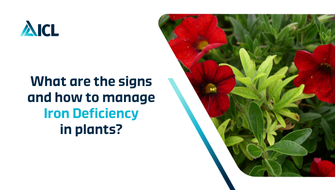Potassium (K) deficiency in horticulture, also known as potash deficiency, is a common nutritional disorder in plants.
Potassium is one of the essential macronutrients that plants need for their growth and development. It plays a crucial role in various physiological processes, such as photosynthesis, enzyme activation, and osmoregulation. When plants lack an adequate supply of potassium, they can exhibit several symptoms and suffer various impacts.
What are the symptoms of Potassium Deficiency?
- Stunted Growth: Plants suffering from potassium deficiency often exhibit reduced growth, including shorter stems and smaller overall size.
- Poor Fruit Development: Fruits may be undersized, with uneven ripening, and may have issues like cracking or splitting.
- Weak Stems: Stems can become weak and more prone to lodging (falling over) or breaking.
- Reduced Disease Resistance: Potassium deficiency can weaken a plant’s ability to resist diseases and pests.
Leaf Symptoms
- Leaf Margins Browning or Scorching: One of the most common symptoms is the browning or scorching of leaf margins. The edges of the leaves may turn brown and appear burnt.
- Leaf Yellowing: Yellowing or chlorosis often starts at the leaf margins and then progresses inward. This yellowing usually appears between the veins, giving the leaves a mottled appearance.
- Leaf Curling: Leaves may curl or roll upwards along the edges.
- Leaf Drop: In severe cases, leaves may drop prematurely.

Potassium Deficiency in Caryopteris
What are the impacts of Potassium Deficiency?
- Reduced Yield: The most significant impact of potassium deficiency is a reduction in crop yield. Fruits and vegetables may be smaller and less numerous, leading to economic losses for farmers.
- Lower Quality Produce: Even if the plants produce some fruits, the quality may be compromised. This can affect the marketability and price of the produce.
- Decreased Tolerance to Environmental Stress: Potassium deficiency can make plants more susceptible to environmental stressors, such as drought, cold, and salinity.

Potassium Deficiency in Primula
How should you manage Potassium Deficiency?
- Soil Testing: Start by conducting soil tests to determine the potassium levels in your soil. This will help you gauge the severity of the deficiency and guide your fertilisation strategy.
- Fertilisation: Apply potassium-containing fertilisers such as potassium sulfate (K2SO4) or potassium chloride (KCl) according to soil test recommendations. Fertilisers should be applied evenly and at the appropriate times during the growing season.
- Organic Matter: Incorporate organic matter into the soil, such as compost or well-rotted manure. Organic matter can help improve the availability of potassium in the soil.
- pH Management: Ensure that the soil pH is within the optimal range for potassium uptake, typically around 6.0 to 7.0. Adjust the pH if necessary.
- Irrigation Management: Proper irrigation practices can help prevent nutrient leaching, which can lead to potassium deficiency. Avoid excessive watering, and use irrigation methods that minimise nutrient loss.
- Crop Rotation: Rotate crops to prevent the depletion of potassium in the soil due to continuous cultivation of potassium-demanding plants.
- Foliar Sprays: In severe cases of deficiency, foliar sprays of potassium-containing fertilisers can provide a quick boost to the plants.

Potassium Deficiency in Kentia
It’s important to note that excessive potassium fertilisation can lead to nutrient imbalances and should be avoided. Regular monitoring of soil nutrient levels and plant health is essential for effective management of potassium deficiency in horticulture.
0 Brands found
4 Products found
13 Resources found



Our knowledge
Tips & tricks, disease prevention, crop and market related information
Explore our knowledge












